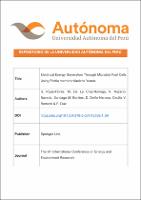Electrical Energy Generation Through Microbial Fuel Cells Using Pichia membranifaciens Yeasts

View/
Author(s)
Rojas-Flores, S.
De La Cruz-Noriega, M.
Nazario-Naveda, R.
Benites, Santiago M.
Delfín-Narciso, D.
Romero, Cecilia V.
Diaz, F.
Date
2023Metadata
Show full item recordPublisher
Springer Link
Journal
The 9th International Conference on Energy and Environment Research
Abstract
The current world's significant problems are due to the dependence on the consumption of environmentally harmful materials for obtaining electrical energy where the search for new generating sources of this resource is a necessity. For this reason, this research tries to provide a novel way of generating electricity by using the Pichia membranifaciens yeast as a fuel source through microbial reactors manufactured at scale with Zn and Cu electrodes. The Pichia membranifaciens yeast was molecularly identified with 99.47% identity, managing to generate current and voltage peaks of 2.782 ± 0.241 mA and 0.865 ± 0.351 V, respectively, with an optimal operating pH of 7.519 ± 0.102 on the 7 days, where the values of electrical conductivity increased to 75.92 ± 3.54 mS/cm. The maximum values of the PD were 5.4534 ± 0.251 W/cm2 at a CD of 361.71 mA/cm2 for a voltage of 0.807 V. This investigation gives high values compared to other experiments using different types of substrates and generating a new natural aggregate to increase electrical values without using chemical compounds harmful to nature.
Type
info:eu-repo/semantics/article
Rights
info:eu-repo/semantics/restrictedAccess
Language
eng
Collections
- Ingeniería Ambiental [83]

